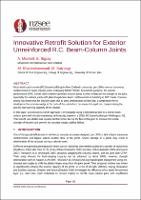| dc.contributor.author | Moshref, Amir | |
| dc.contributor.author | Khanmohammadi, Mohammad | |
| dc.contributor.author | Bigsby, Elanor | |
| dc.contributor.author | Katrangi, Mahmoud | |
| dc.date.accessioned | 2023-08-28T04:23:34Z | |
| dc.date.available | 2023-08-28T04:23:34Z | |
| dc.date.issued | 2023-04-19 | |
| dc.identifier.uri | https://repo.nzsee.org.nz/xmlui/handle/nzsee/2608 | |
| dc.description.abstract | Most reinforced concrete (RC) frame buildings in New Zealand constructed pre-1960s have unreinforced beam-column joints. Following MBIE/NZSEE assessment guidance, the seismic performance of RC frames with unreinforced beam-column joints is often limited by the strength of the joint, especially for exterior joints with plain longitudinal beam reinforcement terminating in 180º hooks. Previous testing has shown that for this joint type, due to bond deterioration and bar slip a compression force is applied to the concrete wedge at the back of the joint which can cause it to spall out, compromising the gravity-load carrying capacity of the column.
An innovative retrofit approach is investigated using a bidirectional test on a corner beam-column joint with the aforementioned deficiencies, based on a 1930s RC frame building in Wellington, NZ. This retrofit uses drilled and epoxied reinforcement bars at the face of the joint to increase the tensile strength of the joint and prevent the concrete wedge spall failure. | |
| dc.language.iso | en | |
| dc.publisher | New Zealand Society for Earthquake Engineering | |
| dc.relation.ispartofseries | 2023;82 | |
| dc.subject | Advancements in research and practice in seismic performance | |
| dc.title | Innovative Retrofit Solution for Exterior Unreinforced R.C. Beam-Column Joints | |
| dc.type | Article | |

